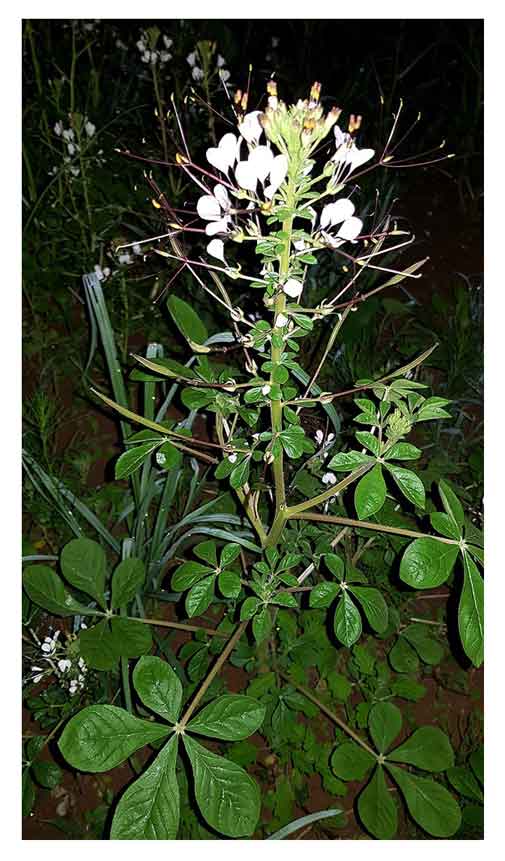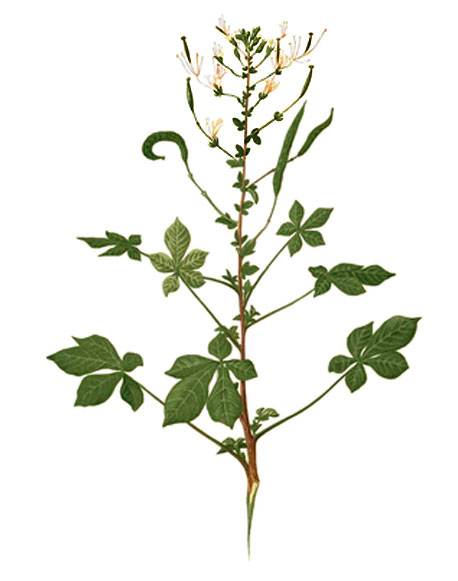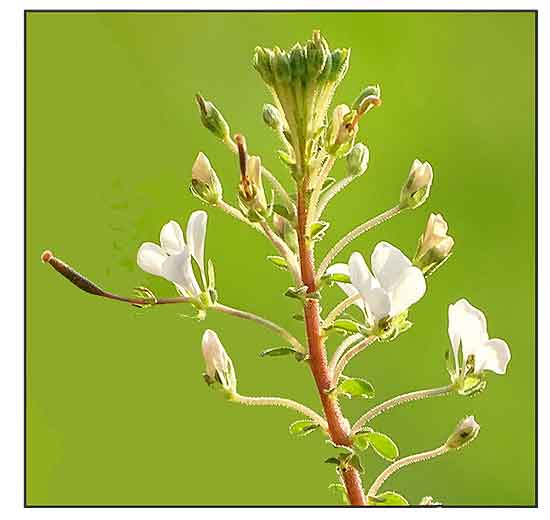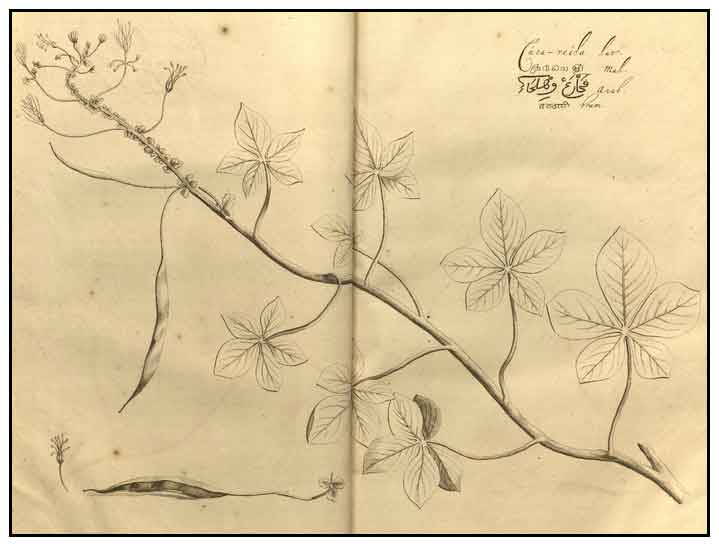 Gen info Gen info
- Cleome is a genus of flowering plants in the family Cleomaceae. It was previously placed in the family Capparaceae, until DNA found the Cleomaceae genera more closely related to the Brassicaceae than then Capparaceae. Cleome contains about 275 species, the vast majority of the Cleomaceae.
(45)
Botany
• Apoi-apoian is an erect, annual, branched, somewhat hairy herb, growing 0.4 to 1 meter high, usually with purplish stems. Leaf has a very long petiole with five leaflets. Leaflets are obovate or oblong-obovate, 2 to 5 centimeters long, pointed at the base, more abruptly pointed at the tip. Flowers are borne in racemes which terminate the branches, showy and somewhat spidery in appearance. Sepals are lanceolate, green, about 4 millimeters long. Petals are white or tinged with purple, 1 to 1.2 centimeters long, withe elliptic to obovate blades. Fruit is a cylindric capsule, 4 to 10 centimeters long, about 5 mm in diameter, containing numerous, small, dark-brown seeds.
Distribution
- Native to the Philippines.
-
At low and medium altitudes, occurring as a weed in waste places, often abundantly, especially near the sea.
- Also native to Angola, Assam, Australia, Bangladesh, Benin, Borneo, Botswana, Burkina, Burundi, Cambodia, Cameroon, Cape Provinces, Cape Verde, Central African Repu, Chad, China, Christmas I., Cocos (Keeling) Is., Congo, Djibouti, East Himalaya, Egypt, Eritrea, Ethiopia, Free State, Gabon, Ghana, Guinea, Guinea-Bissau, Gulf of Guinea Is., Gulf States, India, Ivory Coast, Jawa, Kenya, KwaZulu-Natal, Laos, Lesser Sunda Is., Libya, Madagascar, Malawi, Malaya, Maldives, Mali, Maluku, Mauritania, Mozambique, Myanmar, Namibia, Nepal, New Guinea, Niger, Nigeria, Northern Provinces, Northern Territory, Oman, Pakistan, Palestine,, Rwanda, Saudi Arabia, Senegal, Sierra Leone, Socotra, Somalia, South China Sea, Sri Lanka, Sudan, Sulawesi, Sumatera, Tanzania, Thailand, Togo, Uganda, Vietnam, Yemen, Zambia, Zaïre, Zimbabwe. (28)
- Considered an invasive weed in many places in the U.S. and some places in the Pacific.
 Constituents Constituents
- Plant yields an acrid, volatile oil having the properties of garlic or mustard.
- Seed yields a thick, greenish, drying oil.
- Phytochemical screening of extracts of fresh leaves, roots, stems, seeds, and seed pod yielded alkaloids, flavones (except for roots), sugar, phenolic compounds, essential oil,amino acids, and saponin. (see study below) (3)
- Study yielded biologically active phytochemicals such as triterpenes, tannins, anthroquinines, flavonoids, saponins, steroids, resins, lectins,, glycosides, sugars, phenolic compounds and alkaloids.
- Screening for secondary metabolites
yielded alkaloids, cynanogenetic glycosides and steroidal nucleus. (12)
- In a study of different plant parts, stem extract showed the highest concentration of total phenolics (126 ± 0.55 mg/g), flavonoids (40.58 ± 0.06 mg/g) and flavanols (42.41 ± 0.05 mg /g) while the stem extract had the highest amount of proanthocyanidins (419.01 ± 0.67 mg/g) compared to leaves (403.29 ± 0.89 mg/g) and fruits (107.18 ± 0.59 mg/g). (see study below) (20)
- Phytochemical screening of aerial parts yielded alkaloids, flavonoids, tannins, terpenoids; oils, fats, and steroids were present in the ethanolic extract but were absent in the water extract. (see study below)Â Â Â (24)
- Studies have yielded oleic acid, linoleic acid, palmitic acid, stearic acid, arachidic acid, and a phytosterol from seed oil. Root has yielded two glyco-flavonones as narringenin-4-galactoside-1 and dihydrokaempferol-4f-galactoside-2. (29)
- Studies of seeds for amino acid
have yielded glutamic, arginine, aspartic, leucine, valine, glycine, proline, phenylalanine, isoleucine, threonine, alanine. serine, lysine, tyrosine, and histidine. (29)
- Hydrodistillate constituents of aerial parts analyzed by GC and GC-MS yielded 13 constituents. Major constituent was identified as 1,2-benzene dicarboxylic acid diisooctyl ester (56.4%). Linalool was present to about 3%, while other components were mostly trace. (36)
- Study of whole plant (excluding seeds) isolated a novel dammarane triterpenoid, 20S,24S)-epox-19,25-dihydroxydammarane-3-one hemiketal.
designated as cleogynol. (39)
Properties
- Plant has an odor resembling asafoetida, but more delicate.
- Seeds considered to have properties similar to those of mustard.
- Seeds are febrifuge, antispasmodic, sudorific, anthelmintic, carminative.
- Leaves considered rubefacient and vesicant.
- Studies have suggested antioxidant, immunmodulatory, analgesic, anticarcinogenic, antifungal, antibacterial, muscle relaxant, anti-inflammatory, analgesic, repellent, antihemolytic, antimalarial, antidiabetic, hypolipidemic, hepatoprotective, antiallergic, anthelmintic properties.
Parts used
Leaves, seeds, roots, leaf juice.
 Uses Uses
Edibility / Nutrition
- Leaves and flowers are edible.
- Leaves are bitter, sometimes peppery, akin to mustard greens.
-
Throughout Africa, the tender leaves or young shoots, often the flowers, are boiled and consumed as potherb, relish, flavoring for sauces, stew or side dish. Fresh leaves are bitter and so are cooked with other vegetables; also, are ingredients of mashed foods and dried leaves are ground and incorporated in weaning foods. (8)
- Leaves are boiled and marinated in sour milk for 2-3 days and eaten as a nutritious meal.
- Flavor suggests that of radishes.
- Often pickled with salt and added to rice as a flavoring.
- Rich source of nutrient, especially vitamins A and C, minerals (calcium and iron).
Folkloric
- Bruised leaves used as counterirritant or revulsive.
- Leaves used externally as the seeds of mustard, and taken internally for certain bilious disorders.
- Whole plant made into an ointment applied to pustular eruptions of the skin; simply boiled in oil, used - for cutaneous diseases, especially leprosy.
- In Indo-China, used as antiscorbutic.
- Bruised leaves used as rubefacient and vesicant, producing copious exudation, providing relief obtained from blister without its inconveniences.
- Shangaans used the pounded leaf as counterirritant in rheumatism, neuralgia, headache, stiff neck, taking care to withdraw the application before it produces a blister.
- Leaf juice used occasionally for earache, otorrhea, and other ear affections.
- Root decoction used as mild febrifuge.
- Decoction of seeds used as wash for piles, rheumatism and malarial disorders.
- Seeds are febrifuge and applied locally for headaches.
- In Uganda, weed topically used for treatment of Tinea capitis. (24) In the Nebbi district, Infusion of leaves and stems used as ear and eye drops for ear and eye infections and cataracts; also chewed for stomach aches and food poisoning. (40)
- In Africa, leaves are crushed for a concoction to drink as scurvy cure. In other communities, leaves are boiled and marinated in sour milk to become a nutritious meal, believed to improve eyesight, provide energy, and cure marasmus. Also, highly recommended for pregnant and lactating women. Also, used in the treatment of bronchitis, boils, earaches and nasal congestion and as eyewash.
- In Ayurvedic medicine, it is a chief constituent in Narayana Churna. In Ayurveda, used as anthelmintic, for ear diseases, pruritus, and gastrointestinal maladies. (29)
- In Kenya, concoction of crushed leaves drunk to treat scurvy. (29)
- Consumption of leaves by pregnant women believed to ease childbirth by reducing the length of labor and help postpartum recovery. Infusion or decoction of boil leaves and/or roots used to facilitate labor, treat stomach ache, constipation, conjunctivitis. Sap from leaves used as analgesic for headaches, Sap from pounded young leaves squeezed into ears, nostrils, and eyes to treat earaches and epileptic fits. In Taiwan, used to treat dysentery, gonorrhea, malaria, rheumatoid arthritis. In india, used as rubefacient and anthelmintic. Plant used for treatment of malaria, fevers, piles and rheumatism. (29)
Others
- Seed oil: Used for making soap. Also used for killing head lice. (33)
- Repellent: Useful for intercropping due to insect repellent properties. (43)

Studies
• Antimicrobial / Antifungal / Phytochemicals: Phytochemical screening yielded tannin, alkaloid, flavones, sugar, phenolic group, essential oil, amino acids, and saponin. Antimicrobial activity was shown against Agrobacterium tumefaciens, Penicillium notatum. The extracts of leaves showed the highest activity and the highest activity index was against the fungus P notatum. (1)
• Antimicrobial: Study showed showed activity against A niger, A flavus and Metarhizium anisopliae, with the seed extract showing the highest activity.
• Essential Oil / Tick Repellent: Study of the G. gynandra oil yielded 28 compounds; carvacrol occurred in the largest quantity (29.2%), followed by trans-phytol (24.0%), linalool (13.3%), among others. Tested against the livestock tick, Rhipicephalus appendiculatus, the oil exhibited a repellency effect higher than a commercial arthropod repellent. Methyl isothiocyanate which occurred at a relative percentage of 2.1, not tested in the bioassay due to its toxicity may have contributed significantly to the repellency of the oil. (2)
• Antimycotic / Antibacterial: Study evaluated extracts of fresh leaves, roots, stems, seeds, and seed pod for antimycotic and antibacterial activities. Acetone extracts of all five parts showed significant activity against E. coli and S. aureus. Aspergillus niger, A. flavus and Metarhizium anisopliae were highly susceptible to methanol extracts.. The seed extracts showed highest activity of all the extracts. (3)
• Allergic Disorders / Immunotherapy: Study evaluating the effect of immunotherapy with specific pollen of Gynandropsis gynandra showed both immediate and delayed skin test responses were highly significant. The symptom intensity score and medication was reduced and total IgE levels were inconsistent after the course of IT. (4)
• Immunotherapy: Stu Aeroallergens play a major role in the pathogenesis of respiratory allergic diseases - asthma, rhinitis, atopic dermatitis, urticaria. In a study evaluating the effect of immunotherapy towards whole pollen antigen of G gynandra and its fractions showed a significant increase in IgG and its subclass antibodies specific to Gg pollen.
• Lipid Peroxidation Inhibition / Antioxidant: Study of G. gynandra extract confirmed its chemopreventive efficacy by diminishing the rate of lipid peroxidation and significantly increasing the levels of enzymatic (superoxide dismutase, catalase, glutathione peroxidase) and nonenzymatic (reduced glutathione vitamins E and C, and uric acid) antioxidants.
• Anthelmintic: Study of G gynandra and B coriaceae extracts showed considerable anthelmintic activities against Fasciola gigantica, Taenia solium and Pheretima posthuma. (6) Study pf ethanolic extract of Cleome gynandra against Indian earthworm Pheretima posthuma showed dose dependent anthelmintic activity when compared to standard drug Albendazole. (27)
• Anthelmintic / Seed Oil: Study of seed oils from five medicinal plants, including G gynandra, all showed moderate to significant anthelmintic activity against Pheretima posthuma. (10)
• Anti-Inflammatory / Antinociceptive: Study of G gynandra extract showed significant dose-dependent analgesic and anti-inflammatory activity. (7)
• Modulatory Effect on Hepatocellular Carcinoma: The modulation of glucose-metabolizing enzyme activities play a role in the depletion of energy metabolism that leads to inhibition of cancer growth. In this study, the effect of Gg extract on aflatoxin-induced hepatocellular carcinoma on glucose metabolizing enzymes in rats caused a significant increase in the activities of glycolytic enzymes and an increase in gluconeogenic enzyme activities. The results suggest a definite modulating role on the key enzymes of glucose metabolism in HCC and may be due to phytoactive constituents in the extract. (9)
• Anticancer: Study of methanol extract of Cg in Swiss albino mice against Ehrlich Ascites Carcinoma cell line showed a potent dose-dependent anticancer activity comparable to that of 5-fluorouracil. The methanol extract showed a significant decrease (p<0.01) in tumor volume, viable cell count, tumor weight, and elevated life span of EAC tumor bearing mice. Hematologic abnormalities reverted to normal level in MECG treated mice. (11)
• Antimicrobial / Leaves and Stems: Study evaluated the extract of leaves and stems of G. gynandra and Buchholzia coriacea for antibacterial and antifungal properties. Hexane and methanolic extracts of both plants showed various degrees of activity in both bioassays. Ampicillin and itraconazole were used as standard reference drugs. (12)
• Volatile Constituents / Spider Mite Repellent: Study evaluated G. gynandra leaves in search of compounds for the management of spider mites. Results yielded thirteen volatile compounds including isothiocyanates, aldehydes, esters, alcohols, and terpenes. Spider mite populations were rendered inactive on 2 h exposure to some of the compounds. (15)
• Antinociceptive / Leaves: Study evaluated extracts of leaves for antinociceptive activity using a hot plate test and acetic acid-induced writhing test in mice. Ethanol and aqueous extracts were most active. Results suggested involvement of opioid receptors, and flavonoid and tannin constituents probably responsible for the antinociceptive activity. (16)
• Antineoplastic Agents 540: Study of an entire plant extract based on a bioassay employing cancer lines isolated six cancer cell growth inhibitors which were known flavone apegenin (4) and flavonols 1-3, 5 and 6. The five flavonols inhibited the murine P388 lymphocytic leukemia cell line and all six flavonoids exhibited activity against a panel of six human cancer cell lines. Compound 3, penduletin, inhibited Gram-negative pathogen Neisseria gonorrhea. (17)
• Antiproliferative Effects on Human and Lung Cancer Cells: Study showed both G. gynandra and Piper methysticum possess antiproliferative effects on human lung and stomach cancer cells. (18)
• Anti-Inflammatory / Lysosomal Stability / Adjuvant Induced Arthritis: Study evaluated the anti-arthritic nature of C. gynandra against Freund's complete adjuvant induced arthritis in rats. Study showed antiarthritic property which may be through the prevention of spread of inflammation by the stabilizing action on lysosomal membranes. (19)
• Antioxidant: Study evaluated the phytochemical composition and antioxidant properties of acetone extracts of various parts of C. gynandra. Of different plant parts, stem extract showed the highest concentration of total phenolics (126 ± 0.55 mg/g), flavonoids (40.58 ± 0.06 mg/g) and flavanols (42.41 ± 0.05 mg /g). Reducing power of extracts was significant higher than standard drugs. Activities of plant extracts against ABTS, DPPH, and NO radicals were dose responsive with IC50 values of 0.2, 0.1, and 0.03 mg/g respectively. (see constituents above) (20)
• Immunomodulatory: Study evaluated the immunomodulatory activity in phagocytic activity, cell-mediated and humoral immune system on albino rats. Results showed the ethanolic extract showed significant (p<0.05) dose dependent suppression of the immune system while an aqueous extract showed week immunosuppressive effect. (21)
• Analgesic / Whole Plant: Study of whole plant of Cleome gynandra by writhing method using acetic acid in a mice model showed analgesic activity. Diclofenac sodium was used as standard. (22)
• Hypoglycemic / Hypolipidemic / Leaves: Study evaluated an ethanolic leaf extract of C. gynandra on normal and non-insulin diabetic rats induced by alloxan. Administration of 200 mg/kg EECG significantly (p<0.01) reduced blood glucose (119.24 ± 4.67 mg/dL) compared to control (289.42 ± 5.23 mg dL). There was an increase in HDL, a reduction in triglycerides, total cholesterol, LDL and VLDL. (23)
• Antifungal / Topical Treatment of Tinea Capitis / Aerial Parts: Study evaluated the in vitro antifungal activity against Trichophyton rubrum, T. mentagrophytes, and Microsporum canis of ethanol and water extracts of C. gynandra. Both extracts demonstrated antifungal activity as shown by MIC and MFC for the different extracts, which varies with the type of organism of the clinical fungal isolates. The ethanol extract showed comparable activity to the aqueous extract. (see constituents above) (24)
• Comparative Free Radical Scavenging / Wild & L-Arginine Treated: Study evaluated the DPPH radical scavenging activity of L-arginine treated and wild Cleome gynandra using ascorbic acid as standard. Results showed the ethanolic extract of L-arginine treated CG showed highest DPPH scavenging activity than the other extracts. (25)
• Hepatoprotective / CCl4-Hepatotoxicity / Leaves: Study of methanol leaf extract of Cleoma gynandra showed hepatoprotective activity against carbon tetrachloride induced hepatotoxicity in rats. Results showed dose-dependent reversal (p<0.05) in levels of all estimated biochemical parameters. The hepatoprotective effect can be attributed to high content of flavonoids, tannins, and terpenoids. (26)
• Anti-Diabetic / Anti-Dyslipidemic: Study evaluated the antidiabetic and anti-dyslipidemic effect of C. gynandra plant extract in alloxan-induced diabetic rats. The C. gynandra ethanol extract significantly reduced (p<0.05) serum glucose, elevated dyslipidemic levels, SGOT and SGPT levels. (30)
• Inhibitory Effect on Ovarian Folliculogenesis / Leaves: Cleome gynandra extracts contain phytoestrogenic compounds acting as agonist or antagonist estrogen receptors, affecting steroid hormone levels. Study evaluated the effects of methanolic extract of leaves on the folliculogenesis of female albino mice. Results showed a reducing effect upon follicular development for a period of consecutive 21 days. The number of primordial, primary, secondary, and graafian follicles significant reduced in the CGME and estradiol treated groups. (31)
• Anti-Inflammatory / Adjuvant-Induced Arthritis / Leaves: A methanolic extract of leaves exhibited significant anti-inflammatory activity in Freund's complete adjuvant-induced arthritic rats. There was significant decrease in paw edema with remarkable increase in body weight, along with restoration to near normal levels of abnormal pretreatment hematological and biochemical parameters. The extract showed no harmful effects. (32)
• Comparative Mineral Content / Antioxidant Activity: Study evaluated the mineral constituents, phytochemicals, and antioxidant properties of Cleome gynandra compared to Brassica oleracea and Beta vulgaris (beet). C. gynandra had highest concentrations of phosphorus, potassium, calcium, iron, zinc, ascorbic acid, total phenolics and flavonoids. (Beta vulgaris showed higher content of sodium, magnesium, manganese, copper and ß-carotene). C. gynandra also showed higher antioxidant activity compared to the two vegetables. (34)
• Cosmetic Application / Leaves / Invention: Invention relates to a composition, preferably cosmetic, dermatological pharmaceutical composition of above ground parts, particularly leaves, and a suitable carrier. The composition is to be used for the prevention or treatment of dermatologic pathologies, viz. skin, mucous membranes, or keratinous appendages; prevention of vascular disorders; as anti-acne, anti-aging, healing, slimming, anti-allergy and pro-pigmenting product. (35)
• Antimicrobial / Phytoconstituents / Stem: Study evaluated dried and powdered stems extracted with methanol and chloroform solvents for phytochemicals and antimicrobial activity. Silicagel-G column chromatography yielded four novel compounds viz. ß-amyrin, ß-amyrin-3-O-β-glucopyranoside, stigmasterol, and sitosterol. On antimicrobial testing, the compounds inhibited all tested bacterial and fungal cultures. (37)
• Ameliorative Effect on Scopolamine-Induced Amnesia / Leaves: Study evaluated various extracts of leaves for memory enhancing ability. Exteroceptive behavioral models such as elevated plus maze, Morris water maze, Radial arm maze, Y maze and open field test were used to evaluate learning and memory, while scopolamine served as the natural ageing inducing amnesia in the interoceptive model. The ethanol extract significantly reversed the amnesia induced by scopolamine. Steroids, flavonoids, and the potent antioxidant property of the ethanolic leaf extract may have favorably contributed to the memory enhancing effect. The beneficial effect on memory and learning may be due to facilitation of cholinergic transmission and inhibition of ß-amyloid levels in mouse brain. (38)
• Hypolipidemic / Dexamethasone Induced Hyperlipidemia / Leaves: Study evaluated the hypolipidemic activity of C. gynandra in a in vivo rat model of hyperlipidemia induced by dexamethasone. Results showed significant amelioration of altered serum lipid profile and reduction of atherogenic index as evidenced by histopathological studies. (41)
• Muscle Relaxant / Leaves: Study evaluated the skeletal muscle relaxant activity of N-butanol fraction of leaves of Cleome gynandra in Swiss albino mice and compared with diazepam. Skeletal muscle relaxant activity was assessed by use of Rota rod apparatus. Results showed highly significant reduction in time spent by animals on the revolving rod compared to control (p<0.01). Three different doses showed dose-dependent increase in muscle relaxation. Results suggest potential for the development of cheap, effective, and safe skeletal muscle relaxant drugs. (42)
• Antimalarial Plasmodium berghei: Study evaluated combined methanol and ethyl acetate extracts of plant for in vivo antimalarial activity against Plasmodium berghei NK65 using white albino mice. In vivo antimalarial results showed significant clearance of Plasmodium berghei NK5 from group 4 administered 50 mg/kg of the plant extract and group 7 administered 25 mg/kg of halofantrine. The dose of 50 mg/kbw showed best activity against Plasmodium berghei with 73.2% clearance. (45)
• Effect on Hemolytic Anemia: Study evaluated the efficacy, safety, and phytochemical composition of Cleome gynandra and Solanum scabrum as applied in the treatment of hemolytic anemia in wistar albino rats. Freeze-dried aqueous extract of 250 and 500 mg/kbw were used for 3 weeks. Toxicity testing showed LD50 dose was above 3000 mg/kg. Results showed some hematinic activity against 2,4-dinitrophenylhydrazine induced hemolytic anemia in wistar albino rats. (46)
Availability
Wild-crafted.
|

![]()




 Constituents
Constituents

